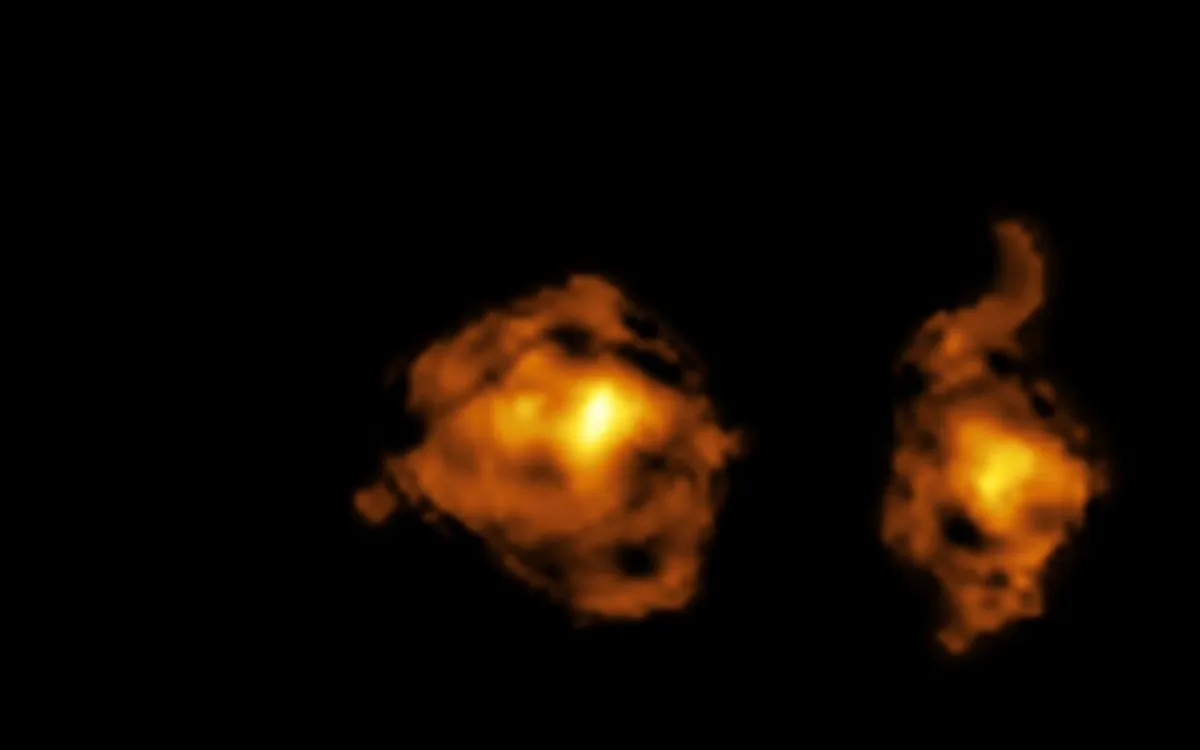
In the cold, ancient reaches of the cosmos, two galaxies are locked in a fierce battle that has persisted for billions of years. However, recent observations by a team of astronomers reveal that this cosmic clash is anything but fair. One of the galaxies is utilizing a quasar to pierce through its opponent, significantly hampering its development. This remarkable phenomenon, referred to by the researchers as a “cosmic joust,” was observed using Chile’s Atacama Large Millimeter/submillimeter Array (ALMA) and the European Southern Observatory’s Very Large Telescope.
The team witnessed a bizarre spectacle: one galaxy emitting a powerful beam of radiation directly into another, disrupting its ability to form new stars. The findings, published in the esteemed journal Nature, provide a front-row seat to some of the most intense intergalactic violence the universe has to offer. Notably, the interaction is so distant that the light captured in the images took an astonishing 11 billion years to reach Earth. The cosmic conflagration is portrayed as it appeared when the universe was merely 18% of its current age.
Despite their seemingly plain appearance in the images, these galaxies are actually hurtling towards one another at an incredible speed of over 311 miles per second (or 500 kilometers per second). “We discovered a quasar—likely triggered by the merging of two galaxies—that is actively transforming the gas structure in its companion galaxy,” stated Pasquier Noterdaeme, a CNRS researcher at the Institut d’Astrophysique de Paris and co-lead author of the study. He further noted, “The idea that galaxy mergers give rise to quasars has long been proposed, mainly supported by statistical studies of host galaxy morphologies. In our case, we caught the two galaxies in the act.”
The team found that the radiation from the quasar—an active galactic core powered by a supermassive black hole—was disrupting regions within the other galaxy. This energy beam is effectively shooting into the other galaxy like a lance, slicing through clouds of gas and dust. Due to this disturbance, the researchers concluded that the affected regions are likely too small to form new stars, meaning that the quasar-wielding galaxy has sabotaged its opponent’s ability to give birth to new light.
“We see for the first time the effect of a quasar’s radiation directly on the internal structure of the gas in an otherwise regular galaxy,” remarked Sergei Balashev, co-lead author of the study and a researcher at the Ioffe Institute in Russia. The galaxy equipped with the quasar isn’t merely chipping away at its opponent; it is also undergoing transformation itself. As the galaxies pass by one another, the interaction funnels gas toward the quasar’s central black hole, fueling it for even more violent outbursts in the future.
This unique cosmic interaction was made visible thanks to ALMA’s high resolution, which allowed astronomers to discern that the light source in deep space was actually two distinct galaxies. Previous observations had made these closely spaced objects appear as a single entity. Additionally, ESO’s X-shooter played a crucial role in scrutinizing the quasar’s light, aiding researchers in understanding how the radiation affected the other galaxy.
As astronomers continue to explore the depths of space, this groundbreaking research sheds light on the intricate and often violent interactions between galaxies, illuminating the pivotal role of quasars in shaping the cosmos.